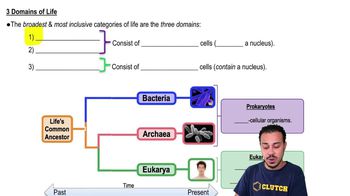List at least two examples of the use of rDNA in medicine and in agriculture.
Which of the following organisms are most closely related? Are any two the same species? On what did you base your answer?
<IMAGE>
 Verified step by step guidance
Verified step by step guidance
Verified Solution
Key Concepts
Taxonomy

Phylogenetics

Species Concept

Match the following choices to the statements in questions 7 through 10.
a. antisense
b. clone
c. library
d. Southern blot
e. vector
A population of cells carrying a desired plasmid.
Match the following choices to the statements in questions 7 through 10.
a. antisense
b. clone
c. library
d. Southern blot
e. vector
Self-replicating DNA for transmitting a gene from one organism to another.
Here is some additional information on the organisms in question 1:
<IMAGE>
Which of these organisms are most closely related? Compare this answer with your response to review question 1.
Use the following choices to answer questions 9 and 10:
a. C. trachomatis
b. E. coli
c. Mycobacterium hominis
d. S. saprophyticus
In cases of NGU, diagnosis is made using PCR to detect microbial DNA.
